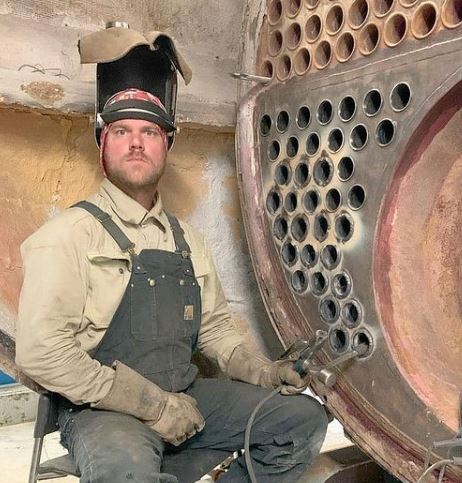MIG welding, also known as Gas Metal Arc Welding (GMAW), is a type of welding that uses a consumable wire electrode and a shielding gas to produce an electric arc between the electrode and the base metal. The heat generated by the arc melts the base metal and the wire electrode, which fuse as they cool to create a strong, permanent bond.
TIG welding, also known as Gas Tungsten Arc Welding (GTAW), is a type of welding that uses a non-consumable tungsten electrode to produce an electric arc between the electrode and the base metal. The heat generated by the arc melts the base metal, fused with a filler metal to create a strong, permanent bond.

What Should Learn Mig Or Tig Welding First?
Learning welding techniques is important for several reasons. Welding is a critical skill in many industries, including construction, manufacturing, automotive, and aerospace. It is also a valuable skill for individuals who enjoy working with their hands and creating things. Welding requires a combination of physical talent, attention to detail, and problem-solving skills. It can be a rewarding and lucrative career for those willing to put in the time and effort to learn and practice.
MIG Welding
MIG welding, also known as Gas Metal Arc Welding (GMAW), is a type of welding that uses a consumable wire electrode and a shielding gas to produce an electric arc between the electrode and the base metal. The heat generated by the arc melts the base metal and the wire electrode, which fuse as they cool to create a strong, permanent bond.
To perform MIG welding, the welder holds a MIG gun, which contains the wire electrode and a trigger that controls the flow of electricity and stands on the opposite side of the base metal from the direction in which the weld will progress. The welder begins by preparing the base metal by cleaning it and ensuring that it is properly positioned and secured. The welder then turns on the power source and adjusts the voltage and wire feed speed to the appropriate levels.
Next, the welder holds the MIG gun at a consistent angle, usually between 10 and 15 degrees, and begins to weld. As the welder moves the MIG gun along the base metal, the wire electrode is fed through the gun and into the arc, where it melts and becomes part of the weld. The welder must maintain a steady hand and a consistent speed to ensure that the weld is smooth and even.
MIG welding is a relatively easy process to learn and is often used for projects requiring a high level of productivity, such as welding car bodies or structural steel. It is also suitable for welding many materials, including steel, aluminum, and stainless steel. However, MIG welding does require the use of shielding gas, which can be expensive and can be a disadvantage in certain situations.
TIG Welding
TIG welding, also known as Gas Tungsten Arc Welding (GTAW), is a type of welding that uses a non-consumable tungsten electrode to produce an electric arc between the electrode and the base metal. The heat generated by the arc melts the base metal, fused with a filler metal to create a strong, permanent bond.
To perform TIG welding, the welder holds a TIG torch, which contains the tungsten electrode and a foot pedal that controls the flow of electricity and stands on the same side of the base metal as the direction in which the weld will progress. The welder begins by preparing the base metal by cleaning it and ensuring that it is properly positioned and secured. The welder then turns on the power source and adjusts the voltage and current to the appropriate levels.
Next, the welder holds the TIG torch at a consistent angle, usually between 5 and 15 degrees, and begins to weld. As the welder moves the TIG torch along the base metal, the tungsten electrode is held in the arc, creating heat that melts the base metal. The welder must hold a filler rod in the opposite hand and add it to the weld puddle as needed to create the desired weld bead.
TIG welding is more difficult to learn than MIG welding, but it is highly valued for its precision and ability to produce high-quality welds. It is suitable for welding many materials, including steel, aluminum, and stainless steel. It is often used for projects that require a high level of aesthetics, such as custom car builds or decorative metalwork. TIG welding does not require shielding gas, which can be advantageous in certain situations. However, it is a slower process than MIG welding and requires a high level of skill and control from the welder.
Comparison of MIG and TIG welding
Several key differences between MIG and TIG welding can help you decide which technique best suits your needs.
- Suitability for different materials: MIG and TIG welding can be used on many materials, including steel, aluminum, and stainless steel. However, MIG welding is generally considered more suitable for thicker materials, while TIG welding is better suited for thin materials. This is because MIG welding uses a consumable wire electrode that adds additional material to the weld, which can benefit thick materials requiring more filler. On the other hand, TIG welding uses a non-consumable tungsten electrode. It requires the welder to add filler metal manually, making it better suited for thin materials where excess filler can be detrimental.
- Precision and control: TIG welding is generally considered more precise and allows more control over the welding process than MIG welding. This is because TIG welding uses a smaller, more focused arc and requires the welder to manually add filler metal, allowing for greater control over the weld bead shape and size. On the other hand, MIG welding uses a larger, more diffuse arc and automatic wire feeding, making it more difficult to achieve the same level of precision.
- Ease of use: MIG welding is generally considered easier to learn and use than TIG welding. This is because MIG welding has a simpler setup and requires less equipment, and the automatic wire feeding makes it easier for the welder to maintain a consistent speed and weld bead size. TIG welding requires more equipment and has a more complex setup, and the manual filler metal addition and foot pedal control can be more challenging for beginners.
Ultimately, the choice between MIG and TIG welding will depend on the specific needs of your project and your preferences and skill level. It may be beneficial to learn both techniques to have a greater range of options for different welding projects.
Conclusion
In conclusion, MIG and TIG welding are useful techniques that can be used for many welding projects. MIG welding is a fast, easy-to-learn process that is suitable for thicker materials and is often used for projects requiring a high productivity level. TIG welding is a slower, more precise process suitable for thin materials and is often used for projects requiring a high level of aesthetics.
When deciding which welding technique to learn first, it is important to consider the specific needs of your project, as well as your skill level and preferences. It may also be helpful to seek guidance from experienced welders and to use proper training resources to ensure that you are learning the technique safely and effectively. Whatever technique you choose, practicing and developing your skills is important to become a proficient welder.

It’s been years since I got into welding as a side hustle. It’s been so long since Doing All kinds of welds for business and pleasure as this is my hobby. Being in this field I have learned from hands-on-experience also came to know what gears work and what doesn’t. The Tig Welder is my own platform where I use to share my experience.






Leave a Reply